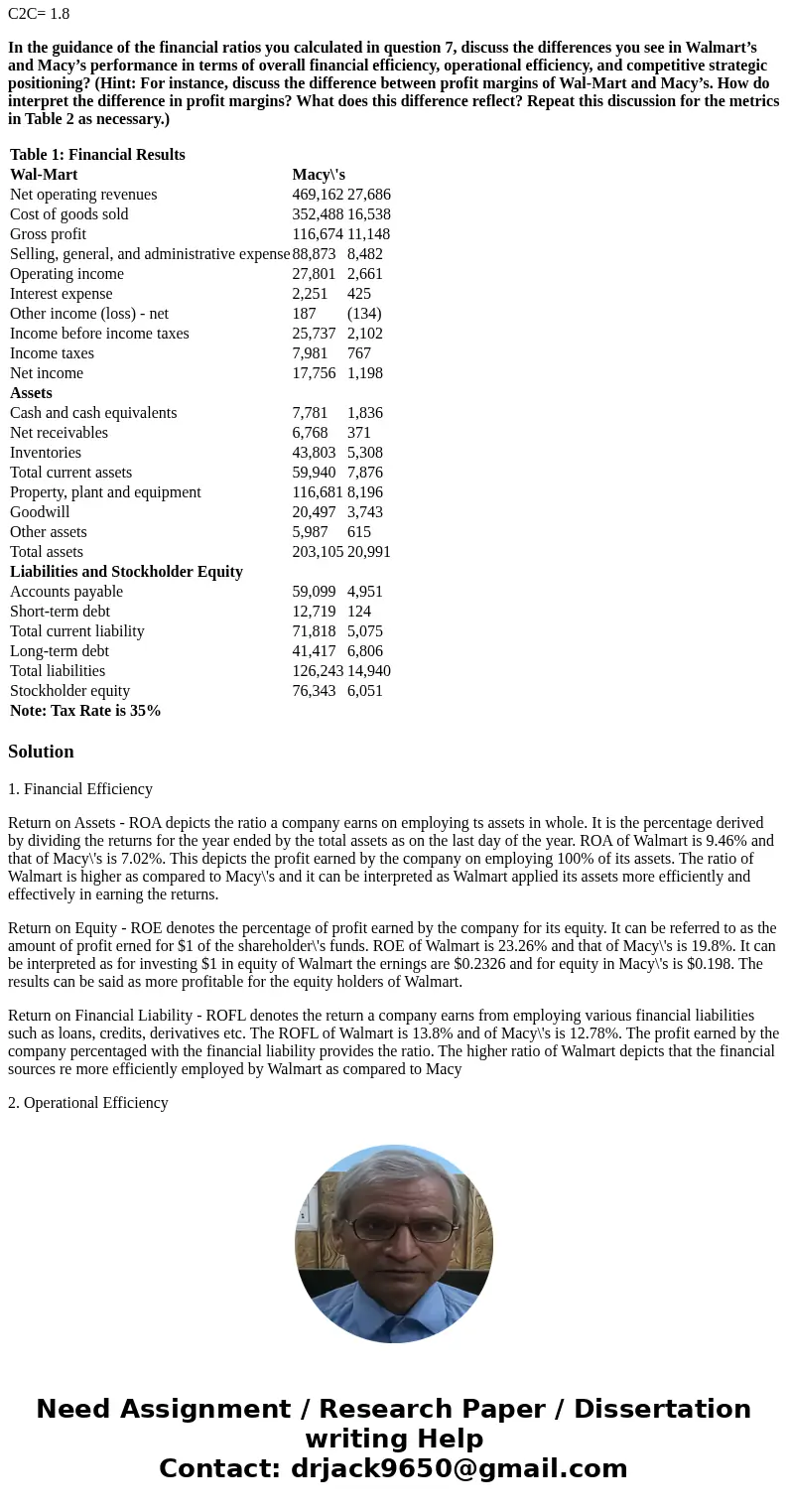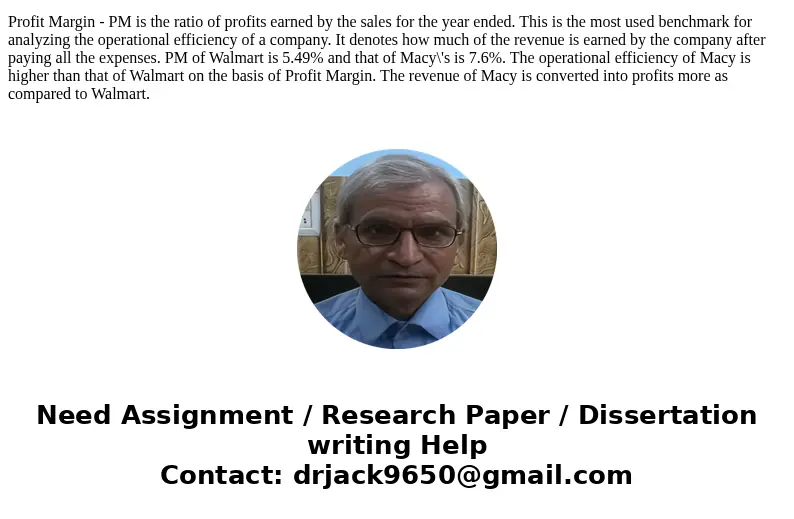Table 1 Financial Results WalMart Macys Net operating revenu
Table 1: Financial Results
Wal-Mart
Macy\'s
Net operating revenues
469,162
27,686
Cost of goods sold
352,488
16,538
Gross profit
116,674
11,148
Selling, general, and administrative expense
88,873
8,482
Operating income
27,801
2,661
Interest expense
2,251
425
Other income (loss) - net
187
(134)
Income before income taxes
25,737
2,102
Income taxes
7,981
767
Net income
17,756
1,198
Assets
Cash and cash equivalents
7,781
1,836
Net receivables
6,768
371
Inventories
43,803
5,308
Total current assets
59,940
7,876
Property, plant and equipment
116,681
8,196
Goodwill
20,497
3,743
Other assets
5,987
615
Total assets
203,105
20,991
Liabilities and Stockholder Equity
Accounts payable
59,099
4,951
Short-term debt
12,719
124
Total current liability
71,818
5,075
Long-term debt
41,417
6,806
Total liabilities
126,243
14,940
Stockholder equity
76,343
6,051
Note: Tax Rate is 35%
7) Walmart
ROA= 9.46%
ROE= 23.26%
ROFL=13.8
PM= 5.49%
AT= 2.31
APT= 5.96
ART= 69.32
INVT= 8.05
PPET= 4.02
C2C= 72.75
Macy’s
ROA= 7.02%
ROE= 19.8%
ROFL= 12.78
PM=7.6%
AT=1.32
APT= 3.34
ART= 74.63
INVT= 3.12
PPET= 3.38
C2C= 1.8
In the guidance of the financial ratios you calculated in question 7, discuss the differences you see in Walmart’s and Macy’s performance in terms of overall financial efficiency, operational efficiency, and competitive strategic positioning? (Hint: For instance, discuss the difference between profit margins of Wal-Mart and Macy’s. How do interpret the difference in profit margins? What does this difference reflect? Repeat this discussion for the metrics in Table 2 as necessary.)
| Table 1: Financial Results | ||
| Wal-Mart | Macy\'s | |
| Net operating revenues | 469,162 | 27,686 |
| Cost of goods sold | 352,488 | 16,538 |
| Gross profit | 116,674 | 11,148 |
| Selling, general, and administrative expense | 88,873 | 8,482 |
| Operating income | 27,801 | 2,661 |
| Interest expense | 2,251 | 425 |
| Other income (loss) - net | 187 | (134) |
| Income before income taxes | 25,737 | 2,102 |
| Income taxes | 7,981 | 767 |
| Net income | 17,756 | 1,198 |
| Assets | ||
| Cash and cash equivalents | 7,781 | 1,836 |
| Net receivables | 6,768 | 371 |
| Inventories | 43,803 | 5,308 |
| Total current assets | 59,940 | 7,876 |
| Property, plant and equipment | 116,681 | 8,196 |
| Goodwill | 20,497 | 3,743 |
| Other assets | 5,987 | 615 |
| Total assets | 203,105 | 20,991 |
| Liabilities and Stockholder Equity | ||
| Accounts payable | 59,099 | 4,951 |
| Short-term debt | 12,719 | 124 |
| Total current liability | 71,818 | 5,075 |
| Long-term debt | 41,417 | 6,806 |
| Total liabilities | 126,243 | 14,940 |
| Stockholder equity | 76,343 | 6,051 |
| Note: Tax Rate is 35% |
Solution
1. Financial Efficiency
Return on Assets - ROA depicts the ratio a company earns on employing ts assets in whole. It is the percentage derived by dividing the returns for the year ended by the total assets as on the last day of the year. ROA of Walmart is 9.46% and that of Macy\'s is 7.02%. This depicts the profit earned by the company on employing 100% of its assets. The ratio of Walmart is higher as compared to Macy\'s and it can be interpreted as Walmart applied its assets more efficiently and effectively in earning the returns.
Return on Equity - ROE denotes the percentage of profit earned by the company for its equity. It can be referred to as the amount of profit erned for $1 of the shareholder\'s funds. ROE of Walmart is 23.26% and that of Macy\'s is 19.8%. It can be interpreted as for investing $1 in equity of Walmart the ernings are $0.2326 and for equity in Macy\'s is $0.198. The results can be said as more profitable for the equity holders of Walmart.
Return on Financial Liability - ROFL denotes the return a company earns from employing various financial liabilities such as loans, credits, derivatives etc. The ROFL of Walmart is 13.8% and of Macy\'s is 12.78%. The profit earned by the company percentaged with the financial liability provides the ratio. The higher ratio of Walmart depicts that the financial sources re more efficiently employed by Walmart as compared to Macy
2. Operational Efficiency
Profit Margin - PM is the ratio of profits earned by the sales for the year ended. This is the most used benchmark for analyzing the operational efficiency of a company. It denotes how much of the revenue is earned by the company after paying all the expenses. PM of Walmart is 5.49% and that of Macy\'s is 7.6%. The operational efficiency of Macy is higher than that of Walmart on the basis of Profit Margin. The revenue of Macy is converted into profits more as compared to Walmart.


 Homework Sourse
Homework Sourse